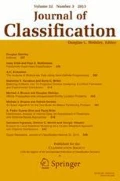Abstract
We extend the standard Bayesian multivariate Gaussian generative data classifier by considering a generalization of the conjugate, normal-Wishart prior distribution, and by deriving the hyperparameters analytically via evidence maximization. The behaviour of the optimal hyperparameters is explored in the high-dimensional data regime. The classification accuracy of the resulting generalized model is competitive with state-of-the art Bayesian discriminant analysis methods, but without the usual computational burden of cross-validation.




Similar content being viewed by others
Notes
This is the case for rare diseases, or when obtaining tissue material is nontrivial or expensive, but measuring extensive numbers of features in such material (e.g. gene expression data) is relatively simple and cheap.
While ϱ(λ) is not a good estimator for ϱ0(λ), Jonsson (1982) showed that in contrast \(\int \!\mathrm {d}\lambda \rho (\lambda )\lambda \) is a good estimate of \(\int \!\mathrm {d}\lambda \rho _{0}(\lambda )\lambda \); the bulk spectrum becomes more biased as d/n increases, but the sample eigenvalue average does not.
MATLAB 8.0, The MathWorks, Inc., Natick, Massachusetts, United States.
Leave-one-out cross-validation using an Intel i5-4690 x64-based processor, CPU speed of 3.50GHz, 32GB RAM. As the data dimension increases above 30,000, RAM storage considerations become an issue on typical PCs.
References
Bensmail, H., & Celeux, G. (1996). Regularized Gaussian discriminant analysis through eigenvalue decomposition. Journal of the American Statistical Association, 91 (436), 1743–1748.
Berger, J.O., Bernardo, J.M., et al. (1992). On the development of reference priors. Bayesian Statistics, 4(4), 35–60.
Brown, P.J., Fearn, T., Haque, M. (1999). Discrimination with many variables. Journal of the American Statistical Association, 94(448), 1320–1329.
Coolen, A.C.C., Barrett, J.E., Paga, P., Perez-Vicente, C.J. (2017). Replica analysis of overfitting in regression models for time-to-event data. Journal of Physics A: Mathematical and Theoretical, 50, 375001.
Efron, B., & Morris, C.N. (1977). Stein’s paradox in statistics. New York: WH Freeman.
Friedman, J.H. (1989). Regularized discriminant analysis. Journal of the American statistical Association, 84(405), 165–175.
Geisser, S. (1964). Posterior odds for multivariate normal classifications. Journal of the Royal Statistical Society. Series B (Methodological), 26(1), 69–76.
Haff, L. (1980). Empirical Bayes estimation of the multivariate normal covariance matrix. The Annals of Statistics, 8(3), 586–597.
Hinton, G.E., & Salakhutdinov, RR. (2006). Reducing the dimensionality of data with neural networks. Science, 313(5786), 504–507.
Hotelling, H. (1933). Analysis of a complex of statistical variables into principal components. Journal of Educational Psychology, 24(6), 417.
Hubert, L, & Arabie, P. (1985). Comparing partitions. Journal of Classification, 2(1), 193–218.
James, W., & Stein, C. (1961). Estimation with quadratic loss. In Proceedings of the fourth Berkeley symposium on mathematical statistics and probability (Vol. 1, pp. 361–379).
Jonsson, D. (1982). Some limit theorems for the eigenvalues of a sample covariance matrix. Journal of Multivariate Analysis, 12(1), 1–38.
Keehn, D.G. (1965). A note on learning for Gaussian properties. IEEE Transactions on Information Theory, 11(1), 126–132.
Ledoit, O., & Wolf, M. (2004). A well-conditioned estimator for large-dimensional covariance matrices. Journal of Multivariate Analysis, 88(2), 365–411.
MacKay, D.J. (1999). Comparison of approximate methods for handling hyperparameters. Neural Computation, 11(5), 1035–1068.
Morey, LC, & Agresti, A. (1984). The measurement of classification agreement: an adjustment to the Rand statistic for chance agreement. Educational and Psychological Measurement, 44(1), 33–7.
Raudys, S., & Young, D.M. (2004). Results in statistical discriminant analysis: a review of the former Soviet Union literature. Journal of Multivariate Analysis, 89(1), 1–35.
Shalabi, A., Inoue, M., Watkins, J., De Rinaldis, E., Coolen, A.C. (2016). Bayesian clinical classification from high-dimensional data: signatures versus variability. Statistical Methods in Medical Research, 0962280216628901.
Srivastava, S., & Gupta, M.R. (2006). Distribution-based Bayesian minimum expected risk for discriminant analysis. In 2006 IEEE international symposium on information theory (pp. 2294–2298): IEEE.
Srivastava, S., Gupta, M.R., Frigyik, B.A. (2007). Bayesian quadratic discriminant analysis. Journal of Machine Learning Research, 8(6), 1277–1305.
Stein, C., & et al. (1956). Inadmissibility of the usual estimator for the mean of a multivariate normal distribution. In Proceedings of the third Berkeley symposium on mathematical statistics and probability (Vol. 1, pp. 197–206).
Zou, H., & Hastie, T. (2005). Regularization and variable selection via the elastic net. Journal of the Royal Statistical Society: Series B (Statistical Methodology), 67(2), 301–320.
Acknowledgements
This work was supported by the Biotechnology and Biological Sciences Research Council (UK) and by GlaxoSmithKline Research and Development Ltd. Many thanks to James Barrett for his support.
Author information
Authors and Affiliations
Corresponding author
Additional information
Publisher’s Note
Springer Nature remains neutral with regard to jurisdictional claims in published maps and institutional affiliations.
Rights and permissions
About this article
Cite this article
Sheikh, M., Coolen, A.C.C. Accurate Bayesian Data Classification Without Hyperparameter Cross-Validation. J Classif 37, 277–297 (2020). https://doi.org/10.1007/s00357-019-09316-6
Published:
Issue Date:
DOI: https://doi.org/10.1007/s00357-019-09316-6




